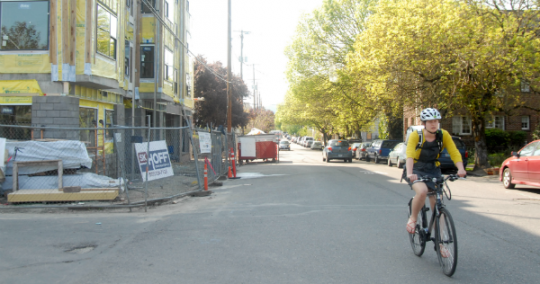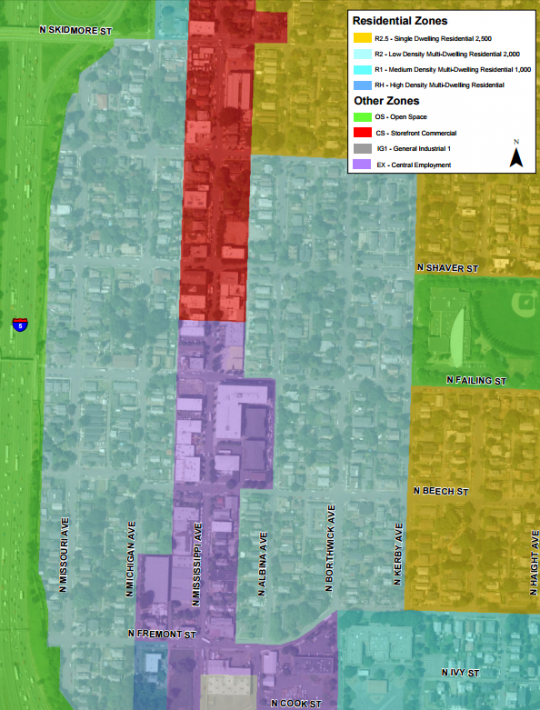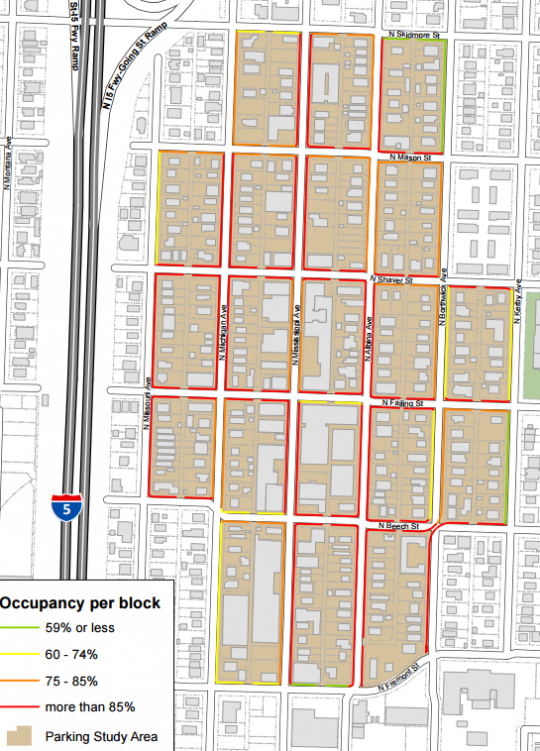
(Photo: M.Andersen/BikePortland)
After months of research and discussion with a massive stakeholders’ group, the Portland Bureau of Transportation on Thursday circulated its first concept for how to deal with shortages of free on-street car parking in some neighborhoods.
The proposal, which the city described Friday as “preliminary,” combines two main ideas:
1) Neighborhoods would get the option to vote to start charging themselves a yet-to-be-determined amount for overnight street parking, and
2) people who live in most of the buildings along commercial corridors wouldn’t get to park in permit-parking areas overnight unless people who live in nearby residences don’t want the space.
The second aspect, which is arguably the defining concept of the proposal, would be accomplished through the city’s zoning code. In any new parking district, residents of buildings in “residential” zones would get the first chance to purchase parking permits. But mixed-use, industrial and employment zones — zones that line almost every crowded commercial corridor in Portland where street parking is scarce — wouldn’t be included in the parking district. This would mean residents there would only be able to purchase parking permits if the “supply” of local parking spaces on nearby residential blocks (as determined by the city) exceeds the “demand” from residential zones.
“Any blockface within the permit area that fronts a residentially‐zoned property could be signed for use by permit holders,” the city’s proposal explains.
For example, here’s a map of the zoning on North Mississippi Avenue. Mixed-use and industrial zones, whose residents would be last in line for parking permits, are marked in red and purple. Residential areas, further from the Mississippi corridor, are marked in other colors.
The permit plan doesn’t offer solutions for what to do about parking on the commercial streets themselves. Options could include meters, shorter-term parking areas, shared off-street parking and other tools.
“Meters are a separate issue,” city project manager Grant Morehead wrote in an email Friday, by way of a city spokesman. He said the neighborhood stakeholder group will tackle that subject in September.
Two other key issues that hasn’t yet been tackled: how much the permits would cost and where the money would go.
Advertisement
Portland’s proposed parking reform could have major long-term impacts on the way the city grows and develops. For example, as our series on the Lloyd District has shown, the transition to paid parking in 1997 was arguably the most important change that set that area on the path to its imminent redevelopment into a dense, potentially bike-oriented urban area.
“If this was the permit program we had in place five years ago, the Division Street battle over parking might have turned out a lot differently.”
— Tony Jordan, centers and corridors stakeholder advisory committee
Advocates for dense, bikeable development hope that paid parking permits will be a way for central Portland neighborhoods to keep adding new housing without also setting aside more and more space for free or cheap car parking.
“If this was the permit program we had in place five years ago, the Division Street battle over parking might have turned out a lot differently,” said Tony Jordan, a member of the city’s stakeholder groups who has advocated for the city to start phasing out its subsidy of auto parking by charging people to store cars on the street. “Armed with the opportunity to permit up as construction set in, neighbors in affected areas might have incentivized developers to add parking or truly work to attract car-free tenants. In areas where the proverbial animals have already left the barn, a system like this will hopefully put pressure on the current landlords to do the latter.”
The detailed proposal from Morehead starts on page 8 of this PDF. Morehead circulated the concept in an email Thursday to members of the “centers and corridors” stakeholder advisory group that has been advising the city on parking reform.
Here’s a crucial passage in the proposal, in which Morehead describes the way that residents of buildings along a corridor might be able to buy parking permits after residents of homes off the corridor have had their chance:
The total number of permits issued within an area would be capped, based on a standard formula that is related to the total supply of on‐street parking. The concept does not include a cap on the number of permits issued to any one address; rather, it proposes a progressive pricing scheme (the second permit would cost more than the first, the third would cost more than the second, etc.). Properties with available off‐street parking would automatically start at the rate for a second permit. Daily guest permits would be available; these are typically sold in packets of 10.
If demand for permits exceeds supply, a waiting list would be maintained. If supply of permits exceeds demand, a neighborhood could decide to sell surplus permits to people outside the area. That would be a detail to be worked out in each implementation plan.
How often would demand for parking permits exceed supply in a given district? That’s hard to say, because if people had to pay for curbside parking permits, they might be more likely to park in garages and driveways, or less likely to have cars at all. However, here’s a map (prepared for the stakeholder advisory committee) that shows the intense demand for the curbside auto parking the city currently provides for free in the Mississippi Avenue area:
“A lot of details remain to be worked out,” Morehead added in the Friday email. “The SAC will surely have a lot to say about this idea.”
Update: The committee, which consists overwhelmingly of residents of residential zones, pretty much liked the proposal.




